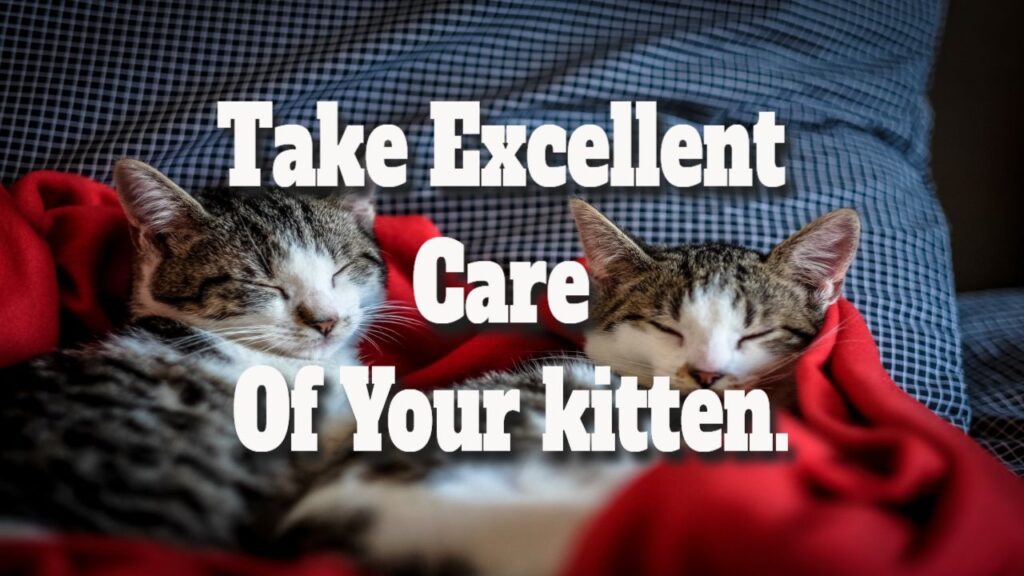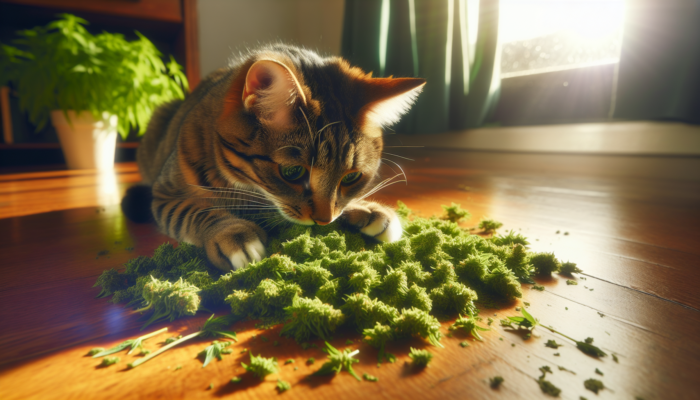Take Excellent Care Of Your kitten.
Contents
Take excellent care of your kitten.
Bring in your new kitty.
Take Excellent Care Of Your kitten.: To begin, ensure that all windows and doors going outside are closed and that any nooks and crannies are blocked up to avoid potential threats. Kittens are curious and can become disoriented or trapped in the most inaccessible areas. Because they are still in the acclimatization phase, you should keep an eye on them for as long as possible.
Kittens are naturally sanitary and prefer not to keep their litter box near their food and water bowls. Cats also prefer to drink in a separate location than where they eat, so keep the water bowl next to the food bowl.
Provide them with a tiny, comfortable bed (but don’t be surprised if they choose where they sleep!) During the first few nights, a warm (not hot) water bottle under a blanket can assist the void caused by the absence of a mother or siblings must be filled up
The world can appear enormous to a tiny kitten. For the first few days, confine it to one room to get familiar with where it feeds, sleeps, and relieves itself.
A litter box is a vital aspect of housetraining because if the cat is used to using it, it will seek it out when it is free to explore the house.
Small children and other pets will be introduced to the kitty.
Proceed with caution while introducing your kitten to other family members and other pets to ensure a smooth transition.
Children
When a new pet enters their home, young children can be overjoyed. As a result, there’s a reasonable risk they’ll overwhelm a new kitten.
Explain that this is not a toy that kids can play with all day. Overly eager children should be kept occupied with other activities so that your kitty can gradually adjust to the new environment and family members.
Teach youngsters to wait until the cat approaches before engaging in play, and keep play sessions brief. Kittens have a natural need to play with their claws and fangs. As a result, teaching your children to concentrate on proper toys as early as feasible will pay off later in life.
Socialization of your kitten
Socialization is essential for your cat to develop the abilities needed to become a well-rounded and happy individual capable of dealing with the obstacles that may face them later in life.
Cats learn a lot in their first two months of life, which moulds their worldview.
They will treat whatever they haven’t learned about in this short time with mistrust and caution in the future. Begin by jotting down all the things that need to be taken into consideration. This encompasses all that the youngster is capable of perceiving.
Touching, stroking, and connecting with people are all skills that kittens must learn because they do not come naturally to them.
When kittens are appropriately introduced, they learn to appreciate direct personal contact with their owners, whereas most adult cats enjoy this for themselves!
Give your kitty some food.
Determine what food your kitty has been eating and serve it to her when you come home. Stomach upset, and diarrhoea might result from a sudden change in food combined with the stress of moving.
You can gradually give the new food to your kitten once it has been adapted to it for a few days. Kittens have small stomachs and require regular feedings.
Providing a portion of high-quality complete food is the simplest approach to feed a growing kitten a healthy diet. Typically, this is dry food, although some companies also provide canned food.
These diets are specifically designed for kittens, who have different nutritional requirements than adult cats. All feeding instructions should be read and followed carefully.
When you feed the kittens, they have unlimited access to dry food (unless other animals are consuming the kittens’ food).
Because canned food spoils quickly in the bowl, it must be consumed in multiple meals throughout the day. Kittens aged eight to twelve weeks require four meals per day, kittens aged three to six months require three meals, and kittens beyond six months require two meals per day.
Milk can cause diarrhoea in cats, so keep it away from them. Kittens, like all animals, require regular access to clean drinking water.
Your kitten’s toilet training
Cats are very clean creatures that will rapidly become housebroken with the right encouragement. Kittens learn to use the litter box from their mothers, but they may also want our assistance.
After a meal, your cat may desire to use the restroom, wake up from a nap, smell the floor, scratch or crawl, and generally appear to need to use the restroom right immediately!
If your cat poopes in other areas of the house, you may wish to confine him to a litter box area until he learns to use it regularly.
You’ll need a plastic litter box that can hold cat litter. Every pet store and supermarket store carries these. Garden soil should not be used since it can spread illnesses to other cats.
In order to capture litter thrown over the side while digging, the litter box should be placed on newspaper. However, the box should not be too deep for your kitten to climb into it. Using an open litter box for the first few weeks of your kitten’s life in the garden will suffice.
If you want the cat to stay using the bowl, buy a covered bowl to provide additional privacy, keep odours out, and prevent messes.
Place the bowl in a calm, easily accessible area where your cat will not be bothered. Keeping the kitten’s food and water bowls and the litter box at a distance is always a good idea since the kitten may be reluctant to use a litter box close to the food.
Always keep the litter box clean. Instead of emptying the entire litter box every day, remove only the soiled litter to encourage the cat to return because it smells “familiar.” Unless your cat has diarrhoea or the litter box is exceptionally dirty, you should only empty it once a week (in which case you should clean it much more frequently). Some disinfectants (for example, Dettol) that become hazy in water are toxic to cats. As a result, when cleaning the litter box, use hot water and a small amount of dishwashing liquid.
Having a cat that refuses to use the litter box might be a problem. All of the following are possible culprits:
It is dirty; in this case, you should clean it more frequently.
It’s too little; an adult cat should be able to spin around in it and utilize it numerous times without getting dirty.
You cleansed it with a chemical with a strong odour.
The kitty’s bed and feeding bowls are obstructing the path.
If your cat doesn’t like the litter you chose for him, try a different brand or go back to an old favourite.
If your cat begins to go outside more frequently, carefully relocate the litter box closer to the door. A few handfuls of litter from the litter box sprinkled on freshly dug garden soil can entice your kitten to dig there.
Remove the litter box from the house only after your kitten has started using the garden.
When should you allow your kitten to go outside?
For at least one week following your kitten’s initial immunisation, keep it in an enclosed space (at 13 to 14 weeks of age, depending on the vaccine).
Take your kitten outside to explore his new surroundings on a dry day and during a peaceful time. Accompany your kitty until she is at ease in the garden and swiftly returns to the house.
Even if your kitten was spayed or neutered before you adopted her, don’t allow her to go outside alone until she’s at least five months old since she’s still young and vulnerable.
Cats prefer to come and leave whenever they please, and the best method for them to do so is with a cat flap.
You may teach your kitten to utilize the cat flap by initially sliding it open and tempting him in with tasty food. Close it gradually, so the kitten learns to push the flap to get through.
If you already have a cat who uses the flap, keep in mind that the kitten may be watching it and learning to open it before you do. Kittens learn new skills quickly by observing other cats.
With a magnetic or electric key on your cat’s collar, you can buy a special cat flap that is activated only by your pet to keep other cats out of your house.
Your cat should be identified and microchipped.
Cats older than six months old who are capable of going outside on their own should be let out more often, you should put an identifying collar on him and potentially carry a magnet or key for an electronic cat flap.
Collars must be applied appropriately because kittens are highly active and curious when they are developing. Injuries can occur if the collar becomes entangled in a branch or fence or if the kitten’s front leg becomes entangled in the collar.
Quick-release collars that open when a cat gets hooked somewhere are the most secure option for all cats. For young, fast-growing cats, check the collar frequently (you should be able to slide a finger or two under the collar) and adjust the collar size accordingly.
It is a good idea to microchip your kitten. Microchips are inserted under the skin between the shoulder blades for long-term identification purposes.
Using a scanner, a “bar code” included in the chip can be scanned. If your kitten is stolen, the code number and personal information will be saved in a national database. Microchipping can be explained to you by your veterinarian.
Unseen dangers
Kittens are curious and will investigate every small, dark space they can burrow into. Check closets, cabinets, sheds, and other areas if your kitten has been missing for an extended amount of time to see whether she has become trapped or stuck.
When not in use, keep the washer and dryer doors closed and inspect them before placing clothing in them. Remove any potentially toxic plants, such as.
Dieffenbachia sp (yarrow).
Poinsettia
The Lilly of the Valley
The Christmas plum
Plant of the castor bean
The avocado tree
Ivy
Cats generally avoid such plants, but kittens may be more intrigued. If you live in a mezzanine or multi-story home, keep windows locked or invest in fly screens to prevent kittens from slipping out.
Garden chemicals should be safely handled, and caution should be shown while using slug baits or chemicals in the garden, as some can be harmful to animals.





Your insights on caring for kittens really resonate with me, especially the emphasis on creating a safe and welcoming environment. When I brought my own kitten home a few months ago, I quickly learned just how vital it is to kitten-proof every corner of the house. They are so curious and adventurous, and I found myself constantly checking nooks and crannies for potential hiding spots or hazards. I even blocked off some spaces using furniture and decorative items to prevent them from wandering into trouble!
It’s great to hear about your experiences with kitten-proofing your home. Those little adventurers really do find the most unexpected spots to explore, don’t they? I’ve also had to block off spaces and even get creative with furniture arrangements. It’s funny how you have to think like a kitten—what looks normal to us can be a whole new world to them.
It sounds like you’ve really embraced the adventure that comes with having a kitten. I can relate to that feeling of needing to kitten-proof everything; it’s amazing how quickly they can find the most unexpected spots. I remember when I brought my first kitten home, I was surprised at how curious they were about everything. It really does push you to see your living space in a new light.
This is such an important reminder about the delicate needs of kittens. I remember bringing my first kitten home and thinking I had prepared everything, only to discover how overwhelmed she was by the sheer size of my living room. It’s so true that creating a safe, cozy space can help them feel more secure and less disoriented.
Caring for a kitten really does require so much thought and attention! I remember when I brought my little furball home; I had to kitten-proof every corner of the house. It’s fascinating how they can squeeze into the tiniest spaces. You’re spot on about the litter box too—keeping it separate from food is essential. I found that when I gave my kitten a cozy spot near my bed, she would feel safe enough to settle in, especially with a little warmth from a snuggly blanket.